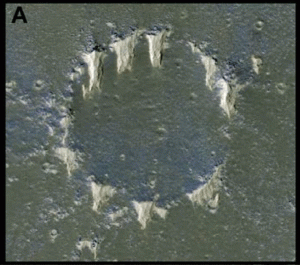Mars has ample loose material blowing around on its surface, a fact which has been known and studied for decades and more. However scientists have paid little attention to sedimentary deposits of dust. New work using detailed images from the HiRISE camera on Mars Reconnaissance Orbiter has recently identified a new type of windblown deposit on Mars: the dust drift.

STREAKY DUST. Bright dust streamers extend like tufts of whiskers downwind from raised features on the rim of this old eroded crater. The dust collects behind the features, where the wind abruptly slackens and the dust falls out of suspension in the air. (Image taken from the online abstract.)
Unlike active sand dunes, which appear dark because they are made of grains of basalt, a dark volcanic rock, the dust drifts appear light in tone, matching that of dust itself.
The discovery was announced by a team of scientists led by Paul Geissler (U.S. Geological Survey). Colin Dundas (also USGS) presented the report (PDF) at the 44th Lunar and Planetary Science Conference in The Woodlands, Texas.
“Bright tapered deposits were first noticed in a HiRISE image of the west flank of Alba Mons,” the team notes. “The dust appears to be temporarily trapped in the lee of crater rims, both inside the craters and along the outside rims where they form streamers.” The geologists add that the deposits don’t fill the smooth crater floors, which suggests that the streamers or drifts need a topographic feature such as an elevated crater rim to form.
Arsia Mons and other volcanos are thickly covered in dust, so the discovery was not too surprising. Then the team found similar features in a region, Solis Planum, where dust is far scantier and surfaces are frequently swept clean. Looking upwind, the researchers spotted a location, Syria Planum, that has stable dust deposits.
The team says, “At first sight, we interpreted these deposits as erosional features, remnants of a formerly extensive layer of dust.” But on closer examination, the drifts’ overall shape didn’t fit with known eroded surfaces. “The deposits are also sinuous in plan,” they noted, which required winds from multiple directions.
“We suggest instead,” they explain, “that the tapered deposits are dust drifts, accumulated during periods of strong surface winds that were heavily laden by dust.” The MER rovers have seen such winds during global dust storms.
“Dust is caught up by topographic obstacles and sticks to the surface, piling up on the downwind rims of the craters and partially infilling the upwind sides,” the researchers say. “Between dust storms, the features must undergo erosion, so they may currently be in an erosional state in spite of the fact that they were formed by dust deposition.”
If this interpretation is correct, they note, dust drifts may let scientists track the direction of windblown dust wherever these features are found.








